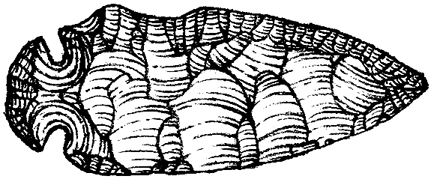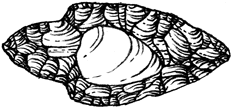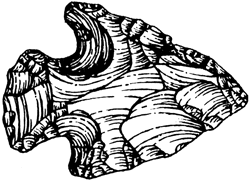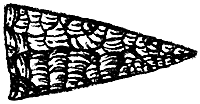Cultural Chronology of Indiana
Indiana's prehistory (the time before written records were kept) includes a variety of cultures spanning almost 12,000 years. The chart below includes (from left to right) the name and approximate age of the culture, an image of a representative artifact, and some characteristics of the culture or time period. Drawings of projectile points are by Amy Johnson and James Mohow, Division of Historic Preservation and Archaeology.
Paleoindian

(ca. 10,000-7500 B.C.)
- earliest known human inhabitants of the Americas, including Indiana
- lived during last glacial advance; mastodons still roamed Indiana
- nomadic hunters and gatherers, lived in small bands of related people
- left behind well-made stone tools including Clovis, Agate Basin, and Hi-Lo points
Early Archaic

(ca. 8000-6000 B.C.)
- climate more similar to today
- greater numbers of sites; rise in population
- nomadic, seasonally roaming and exploiting environment
- evidence of cremation mortuary practices
- variety of stone tool types including grinding stones and pitted stones for food processing
Middle Archaic

(ca. 6000-3500 B.C.)
- climatic warming trend
- sites larger; reflect longer-term settlements
- mortuary activities including human and dog burials
- side notched points and grooved axes appear
Late Archaic

(ca. 4000-1500 B.C.)
- more recognizable cultural groups such as French Lick, Bluegrass, Glacial Kame, Early Red Ochre, and Maple Creek
- scheduled harvesting activities of animal and plant resources, early selectivity of certain plants
- many site types occur including mounds
- large cemeteries
- tool types include woodworking and food processing implements
Terminal Late Archaic

(ca.1500-700 B.C.)
- barbed or small projectile points
- turkey-tail points, copper implements, and use of red ochre
Early Woodland

(ca. 1000-200 B.C.)
- fired clay pottery vessels, found in broken fragments or sherds
- large bladed projectile points
- selection of certain plants and horticulture
- sites with mound groups occur
Middle Woodland

(ca. 200 B.C.-A.D. 600)
- large trade networks of more exotic goods: copper, mica, Gulf Coast marine shells
- large earthworks and ceremonial sites
- expanded stemmed points and blade technology
- horticulture and gardening
- specific design motifs for Hopewellian vessels
Late Woodland

(ca. A.D. 500-1200)
- first intensive maize agriculture, hoes for agriculture
- bow and arrow and the first notched and unnotched stone arrowheads
- sites smaller, more scattered, fewer mounds
- ceramic pots with collared or thickened rims
Mississippian

(ca. A.D. 1000-1650)
- large-scale maize, beans, and squash agriculture
- shell-tempered pottery
- Yankeetown phase: characteristics of both Late Woodland and Mississippian
- Middle Mississippian--"classic" traits of complex and ranked societies: Angel Mounds, the Vincennes Culture, the Caborn-Welborn phase
- Upper Mississippian--fewer mound complexes, smaller and more dispersed: Fisher, Huber, and Fort Ancient
Protohistoric

(ca. A.D. 1450-1650)
- precontact Native American groups which may have continued into the times of European exploration and settlement of Americas and written history, and/or may have been predecessors to historic tribes in the area; in Indiana there is little direct evidence of associations with historic tribes
Historic

(ca. A.D. 1650-Present)
- peoples with Old World and various ethnic and religious back-grounds settled in Indiana: French, British, African-American, German, Irish, Hispanic, Swiss, Baltic, Quaker, Amish are examples
Source: Jones and Johnson, 2-18; James R. Jones III, State Archaeologist.
